Reviewing the principles of RNAi, its application in fighting viral infections and progress made in RNAi-based therapy for viral shrimp diseases
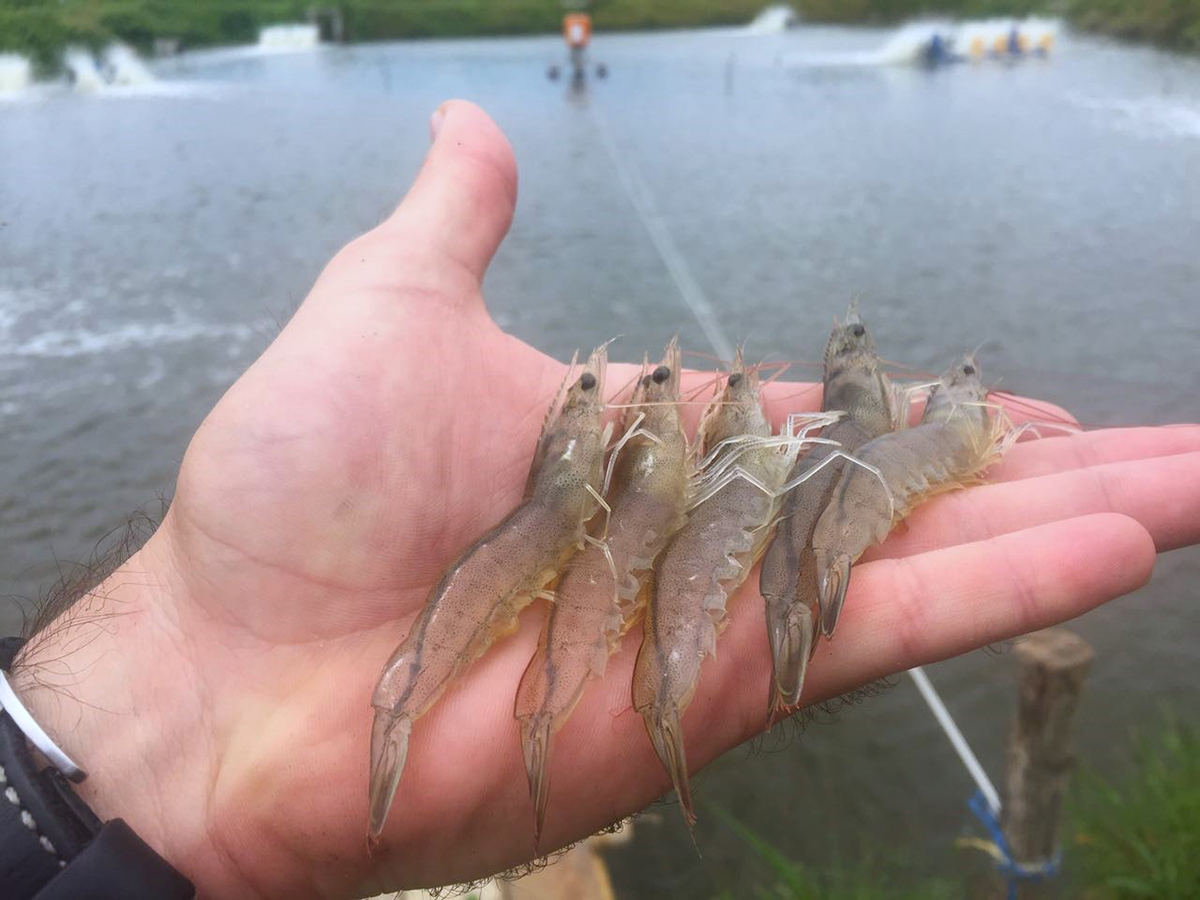
Shrimp diseases pose significant challenges to the farmed shrimp industry, leading to substantial economic losses worldwide. Infectious agents such as bacteria, fungi, and viruses, have emerged as major culprits responsible for devastating shrimp populations. The majority of shrimp diseases result from viral infections, and their detrimental impacts are almost four times stronger compared to bacterial diseases.
Appropriate shrimp farm management practices can often stop parasitic and bacterial diseases from spreading, but this preventive approach may not be as effective against viral diseases. Conventional approaches to disease management, including antibiotics and vaccines, have limitations in terms of efficacy, specificity and environmental impact. As a result, there is a pressing need for innovative therapeutic strategies that can effectively combat these diseases while minimizing their detrimental effects.
Ribonucleic acid, or RNA, plays a key role in turning the instructions in the DNA of a genome into functional proteins in the cells of the organism. RNA interference (RNAi) is a cellular mechanism that regulates gene expression by suppressing the activity of specific genes. RNAi technology has gained considerable attention as a promising tool for the treatment of shrimp diseases. It is a mechanism that regulates gene expression by efficiently degrading target messenger RNAs (mRNAs), leading to the silencing of target genes in pathogens, and offers a targeted approach to interfere with the replication and pathogenesis of infectious agents, making it an attractive alternative for disease control in shrimp aquaculture.
This article – summarized from the original publication (Alam, A. et al. 2023. RNAi-Based Therapy: Combating Shrimp Viral Diseases. Viruses 2023, 15(10), 2050) – presents an overview of the present situation and upcoming approaches related to the therapeutic use of RNAi to combat viral diseases in shrimp.
Shrimp RNAi as a virus-fighting weapon
The precise molecular mechanisms underlying the immune responses against viruses are not yet known for most crustacean species. Therefore, it is crucial to comprehend how viruses enter and spread in shrimp, and the interactions between the host and the pathogen at molecular and cellular levels, to develop effective strategies for combating viral infections in shrimp.
The discovery of RNAi has led to the identification of key proteins involved in the RNAi pathway in species such as the black tiger (P. monodon), Pacific white (L. vannamei) and Kuruma (Marsupenaeus japonicus) shrimp species. This confirms the existence of the RNAi machinery in shrimp. Consequently, specific sequences of double stranded RNA (dsRNA) derived from genes of economically significant shrimp pathogens such as IHHNV, TSV, WSSV and YHV have been targeted, and their effectiveness in promoting shrimp survival and interfering with viral replication has been demonstrated.
Multiple studies have shown that administering pathogen-specific dsRNA/siRNA (a double-stranded RNA molecule that is non-coding; also known as silencing RNA and short interfering RNA) either before or at the same time as a viral challenge can effectively inhibit the replication of various virus species. Conversely, it was also demonstrated that delivering RNAi-inducers to shrimp that are already infected can have a therapeutic effect. According to available literature, the silencing of viral structural and non-structural proteins simultaneously, as well as targeting both host and viral genes, significantly improves the therapeutic response.
RNAi offers a suitable alternative strategy by degrading the mRNA responsible for crucial viral proteins, effectively preventing the production of functional viral particles. The efficacy of RNAi has been demonstrated in combatting various viral infections. Numerous research investigations involving the targeted suppression of particular genes have employed sequence-specific dsRNA to impede the replication of important pathogenic viruses such as TSV, IHHNV, YHV, WSSV, LSNV and GAV in shrimp.
Protection by novel RNA nanovaccine against White Spot Syndrome Virus in shrimp
Delivery strategies of RNAi molecules
The method of delivering therapeutic molecules in RNAi-based therapy is a crucial concern. Gaining insights into gene functionality and managing diseases in diverse aquatic organisms, it is essential to optimize effective protocols for delivering RNA molecules into cells or organisms. RNAi holds great potential for treating a wide range of diseases. However, the successful translation of RNAi from the laboratory to real-world applications faces challenges in delivering RNA molecules to specific cells of therapeutic interest within the organism. Various barriers exist, both inside and outside cells, that require careful design of delivery strategies.
A variety of delivery techniques have been developed to effectively transport RNAi molecules, both in laboratory settings and in living organisms. These methods include electroporation, microinjection, oral administration, polymer-based systems, protein-based systems and lipid nanoparticles (Fig. 1). The approach chosen will depend on the objectives of the study, the cell types that will be targeted, and/or the accessibility of the target. There are benefits and drawbacks to each delivery strategy.
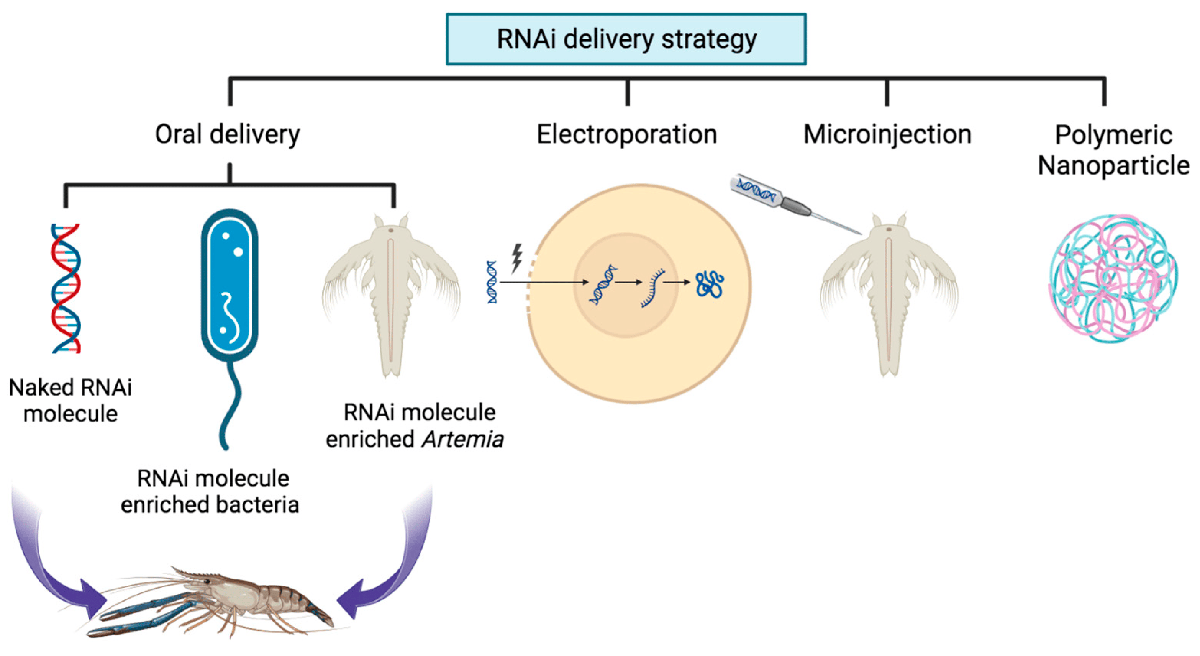
The most effective delivery of RNAi molecules has been achieved by the oral intake of dsRNA-enriched bacteria and viable brine shrimp (Artemia) zygotes (fertilized egg cell from the union of a female egg with a male sperm), and the oral route stands out as the most encouraging approach for delivering RNAi in aquatic environments.
Challenges in RNAi therapy
RNAi has gained recognition as a potent technique for modulating gene function and is seen as a promising approach for disease pathogen control in aquaculture. Despite the enthusiasm surrounding this impressive biological mechanism for precise gene regulation, several challenges and considerations need to be addressed before RNAi therapy can be practically implemented in shrimp aquaculture. These challenges include the risk of off-target effects, the activation of innate immunity, and notably the successful administration of RNAi agents in vivo.
Ensuring the specificity of RNAi molecules is crucial to avoid unintended silencing of non-target genes. Off-target effects, where unintended genes are suppressed, can lead to undesirable consequences and potential side effects. The theoretical specificity of RNAi is not fully realized, and off-target effects represent a significant challenge in the field of RNAi-based therapeutics. The comprehensive impact of individual siRNAs on the entire genome is largely unknown and difficult to predict. Several computational design tools have been created to systematically and precisely assess the off-target impacts of RNAi between specific sequences and target genes.
The effective administration of RNAi molecules to particular cells or tissues remains a significant hurdle to developing a safe and successful in vivo RNAi therapy. Therefore, it is fundamental to have suitable delivery techniques that enhance the concentration of specific sequences within cells and assist in their liberation into the cell. Improper selection of a delivery vector can diminish gene-silencing activity, increase unintended off-target effects, and lead to toxicity. Overcoming the barriers of cellular and tissue-specific delivery is crucial for effective RNAi therapy.
Another crucial practical concern that must be considered is the potential for certain viruses to evade RNAi-mediated suppression. This evasion can occur through mutations in the targeted region and the presence of viral suppressors. To counteract the emergence of resistant viruses, one strategy is to simultaneously target multiple viral sequences using a pool of RNAi sequences, and there are other strategies.
Additionally, RNAi molecules and other nucleic acids have the potential to trigger immune responses by being perceived as viral infections, which activate the interferon system. The immunogenicity (ability of a foreign substance, such as an antigen, to provoke an immune response in the body of a human or animals) of RNAi molecules, along with the delivery systems used, can result in undesired immune reactions or diminished therapeutic effectiveness.
It is crucial to effectively handle the immune response and minimize any immune-related adverse effects in order to ensure the success of RNAi therapy. Addressing these challenges through ongoing research and technological advancements will contribute to the successful implementation of RNAi therapy and its potential as a targeted therapeutic approach for various diseases.
Ultraviolet A photoperiod regimes have varying effects on Pacific white shrimp
Perspectives
RNAi offers a powerful tool to combat viral, bacterial and parasitic infections that pose significant threats to shrimp populations. By targeting specific genes involved in the pathogen’s life cycle or the shrimp’s immune response, RNAi can effectively silence the expression of these genes, inhibiting the growth and replication of pathogens. This approach could help mitigate disease outbreaks, reduce mortality rates, and improve the overall health of shrimp stocks. Additionally, RNAi can be used to enhance the shrimp’s innate immune system, boosting their resistance against various pathogens.
The advancement of RNAi technology, from its initial discovery to potential clinical applications, has been remarkable. RNAi has recently emerged as a powerful tool for gene inhibition and shows promise in managing viral diseases in shrimp. The excitement and anticipation surrounding RNAi are well-founded; however, there are several challenges and considerations that need to be addressed for the practical application of this modern technology in aquaculture. These include the careful design of RNA constructs, optimizing the dosage, selecting an effective delivery strategy, implementing chemical modifications to enhance stability, and improving cellular uptake.
The findings and insights we discuss here offer great promise for RNAi- based therapy. With the increasing occurrence of viral outbreaks among shrimp populations, there is an urgent requirement for enhanced therapeutic measures to effectively manage and control these diseases. If the challenges mentioned earlier can be addressed in a logical and systematic manner, RNAi-based therapies hold significant potential for combating these viral pathogens in shrimp aquaculture compared to conventional approaches, particularly in terms of specificity, targeted action and reduced environmental impact.
Despite the obstacles that lie ahead, RNAi remains the most promising avenue for developing powerful and innovative therapeutic approaches against shrimp viral diseases. However, further research and development efforts are required to overcome the existing challenges and bring this game-changing remedy into practical application.
Now that you've reached the end of the article ...
… please consider supporting GSA’s mission to advance responsible seafood practices through education, advocacy and third-party assurances. The Advocate aims to document the evolution of responsible seafood practices and share the expansive knowledge of our vast network of contributors.
By becoming a Global Seafood Alliance member, you’re ensuring that all of the pre-competitive work we do through member benefits, resources and events can continue. Individual membership costs just $50 a year.
Not a GSA member? Join us.
Author
-
Md. Shahanoor Alam
Corresponding author
Department of Genetics and Fish Breeding
Bangabandhu Sheikh Mujibur Rahman Agricultural University, Gazipur 1706, Bangladesh
Tagged With
Related Posts
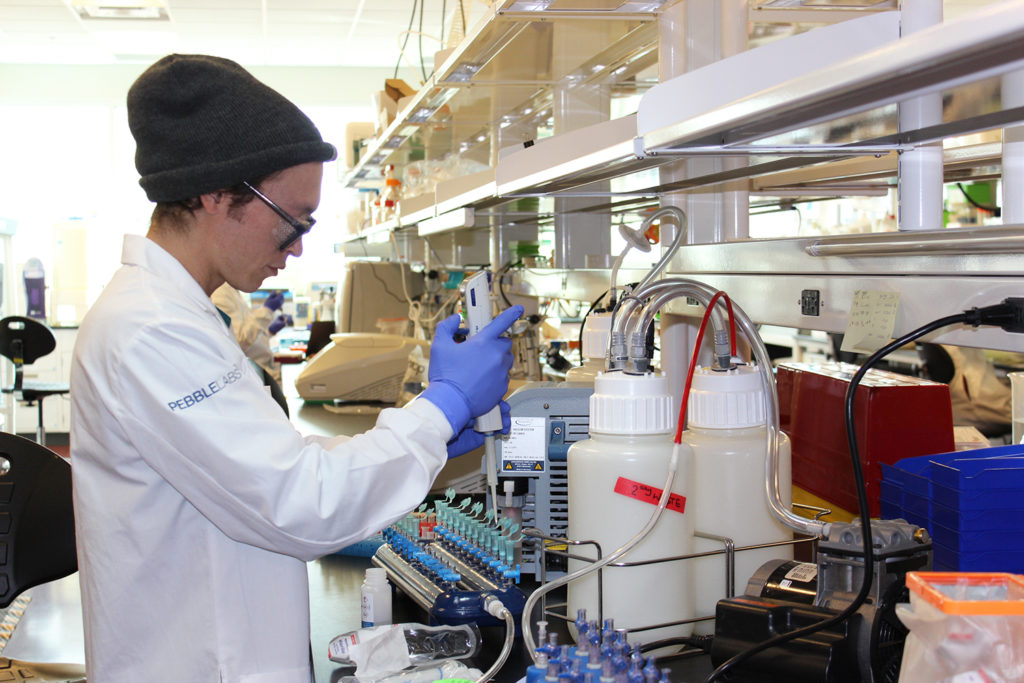
Health & Welfare
Can shrimp diseases be beaten by bacterial interference?
Biotech company Pebble Labs is harnessing bacteria to block the transmission of virulent shrimp diseases in a process known as RNA interference, or RNAi.
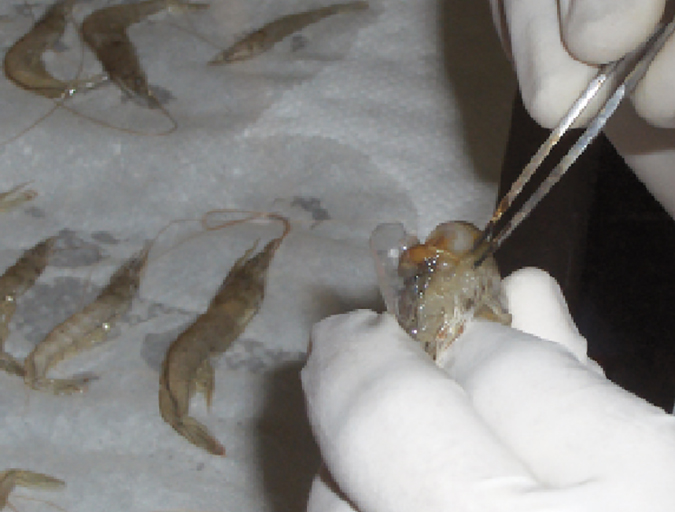
Health & Welfare
Double-stranded RNA against WSSV genes provides antiviral protection in shrimp
Silencing genes in white spot syndrome virus (WSSV) with critical roles in replication could provide a strong antiviral effect and thus reduce shrimp mortality. The authors therefore established a study to evaluate the antiviral efficacy of double-stranded (ds)RNA against non-structural WSSV genes.
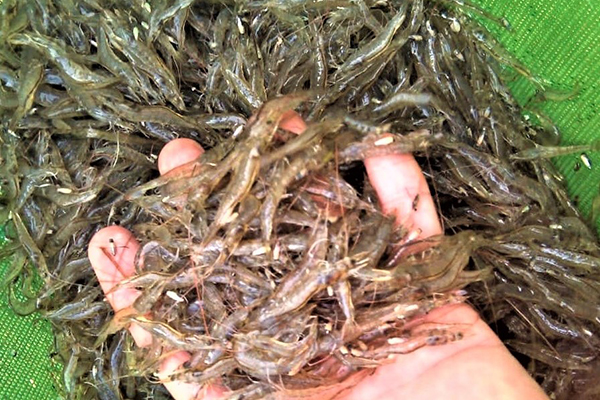
Health & Welfare
Protection by novel RNA nanovaccine against White Spot Syndrome Virus in shrimp
A safe, effective and field-applicable RNA nanovaccine can be realistically designed against infectious diseases affecting aquaculture.
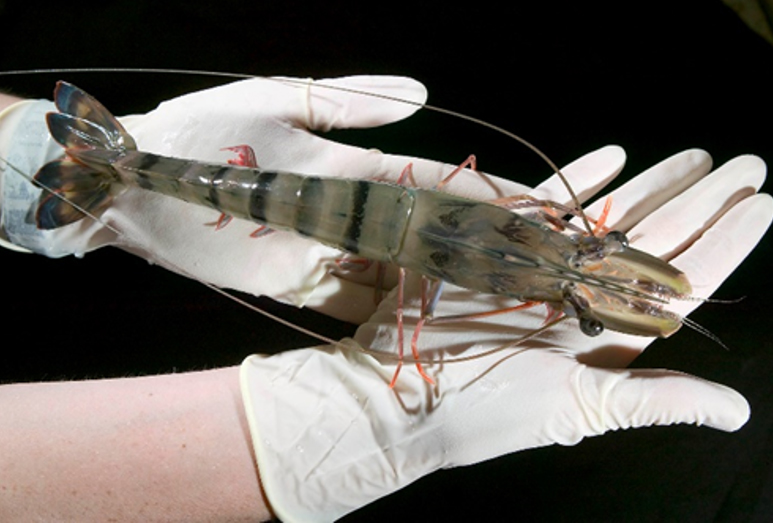
Health & Welfare
Reduced growth performance of black tiger shrimp infected with IHHNV
This study simulated the commercial grow-out of two cohorts of P. monodon that differed in their broodstock IHHNV infection loads, and showed that the viral prevalence, survival and growth performance of pond progeny were significantly affected.



